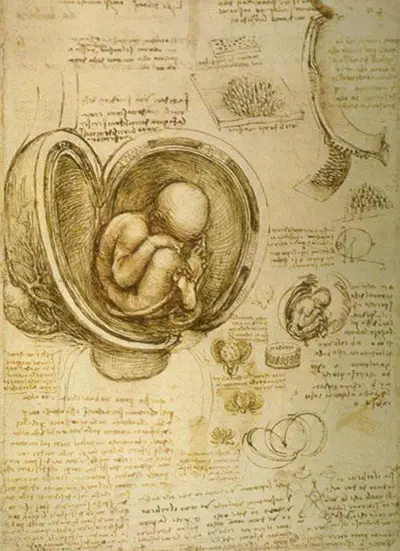His sketches of an embryo in the womb demonstrate the rigor and inquisitiveness of a scientist as well as the skill of an artist.
Da Vinci befriended the professor of anatomy, Marcantonio della Torre in 1506 and took part in many dissections of human cadavers, including, at some point around 1510, the body of a heavily pregnant woman.
It is thought that da Vinci was the first person to draw a human embryo positioned accurately in the womb, along with the vascular system of the uterus, cervix and vagina.
At the time it was widely believed that the womb was divided into many chambers, da Vinci correctly drew just one. The embryo is shown curled up in the now familiar fetal position, with legs crossed at the ankles and the umbilical cord clearly visible.
The drawing, in black chalk and sanguine with ink wash and pen on paper, is surrounded by notes and smaller studies, including detailed cross sections of the uterine walls.
A second page includes further drawings of the fetus from different angles, a study of the external female genitalia, and a note to "Ask Biagino Crivelli's wife how the capon rears and hatches the eggs of hens when he is unplucked" which demonstrates a scientific interest in the biological process of reproduction far beyond improving his depiction of the human body.
Each page is around 30cm by 22 cm (12 inches by 8.5 inches) a little larger than a modern A4 page.
Da Vinci's careful use of cross sections and multiple views has been likened to architectural drawings and allowed him to accurately record the nerves and cardio-vascular system of the female reproductive organs in a way that is mostly accurate and familiar to modern eyes.
However da Vinci did make some mistakes, drawing cotyledons, fleshy projections of the placenta which resemble flowers. He had previously seen cotyledons in dissections of pregnant cows, but they are not present in the placentas of humans.
Still, da Vinci's anatomical drawings are the foundation on which modern anatomical illustration is built, and were a leap forward from the general understanding of human anatomy at the time.
Da Vinci never published his anatomical work and other sketches, although there is some evidence that he intended to do so. He left them to his friend and pupil, Francesco Melzi, who organised much of the vast collection of da Vinci's drawings and notes.
The study of Embryo in the Womb now belongs to the Royal Collection and is housed in Windsor Castle in the United Kingdom.


